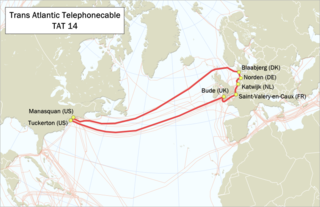
TAT-14 was the 14th consortium transatlantic telecommunications cable system. In operation from 2001 to 2020, it used wavelength division multiplexing. The cable system was built from multiple pairs of fibres—one fibre in each pair was used for data carried in one direction and the other in the opposite direction. Although optical fibre can be used in both directions simultaneously, for reliability it is better not to require splitting equipment at the end of the individual fibre to separate transmit and receive signals—hence a fibre pair is used. TAT-14 used four pairs of fibres—two pairs as active and two as backup. Each fibre in each pair carried 16 wavelengths in one direction, and each wavelength carried up to an STM-256. The fibres were bundled into submarine cables connecting the United States and the European Union in a ring topology.

The Svalbard Undersea Cable System is a twin submarine communications cable which connects Svalbard to the mainland of Norway. The two optical fiber cable consist of two segments, from Harstad to Breivika in Andøy, and from Breivika to Hotellneset near Longyearbyen in Svalbard. The segments from Harstad to Breivika are 74 and 61 kilometers long, respectively, and the segments from Breivika to Hotellneset 1,375 and 1,339 kilometers. Each consists of eight fiber pairs and there are twenty optical communications repeaters on each segment. Each segment has a speed of 10 gigabits per second (Gb/s), with a future potential capacity of 2,500 Gbit/s. The system is now the sole telecommunications link to the archipelago.
Fibre-optic Link Around the Globe (FLAG) is a 28,000-kilometre-long fibre optic mostly-submarine communications cable that connects the United Kingdom, Japan, India, and many places in between. The cable is operated by Global Cloud Xchange, a subsidiary of RCOM. The system runs from the eastern coast of North America to Japan. Its Europe–Asia segment was the fourth longest cable in the world in 2008.

Hibernia Networks, alternately known as Hibernia Atlantic, was a privately held, US-owned provider of telecommunication services. It operated global network routes on self-healing rings in North America, Europe and Asia including submarine communications cable systems in the North Atlantic Ocean which connected Canada, the United States, the Republic of Ireland, the United Kingdom and mainland Europe. Hibernia managed cable landing stations in Dublin, Republic of Ireland; Coleraine, Northern Ireland; Southport, England; Halifax, Canada; Lynn, Massachusetts, United States.
SEA-ME-WE3 or South-East Asia - Middle East - Western Europe 3 is an optical submarine telecommunications cable linking those regions and is the longest in the world. Completed in late 2000, it is led by France Telecom and China Telecom, and is administered by Singtel, a telecommunications operator owned by the Government of Singapore. The Consortium is formed by 92 other investors from the telecom industry. It was commissioned in March 2000.

South East Asia–Middle East–Western Europe 4 is an optical fibre submarine communications cable system that carries telecommunications between Singapore, Malaysia, Thailand, Bangladesh, India, Sri Lanka, Pakistan, United Arab Emirates, Saudi Arabia, Egypt, Italy, Tunisia, Algeria and France. It is intended to be a complement to, rather than a replacement for, the SEA-ME-WE 3 cable.

Atlantic Crossing 1 (AC-1) is an optical submarine telecommunications cable system linking the United States and three European countries. It transports speech and data traffic between the U.S., the U.K., the Netherlands and Germany. It is one of several transatlantic communications cables. It was operated by American company Level 3 Communications and Irish company Tyco International, until their respective mergers in 2017 and 2016 with other companies.

Yellow / AC-2 is a submarine telecommunications cable system linking the United States and the United Kingdom. The cable is wholly owned by CenturyLink in the US following its acquisition of Global Crossing. The original owners, which each owned two of the fibre pairs, gave this cable system different names, so it is known as both Yellow and AC-2. It has a capacity of 320 Gbit/s as of January 2007, upgradeable to 640 Gbit/s.

LEV is a submarine telecommunications cable system in the Mediterranean Sea linking Italy, Cyprus and Israel.
TGN-Pacific is a submarine telecommunications cable system transiting the Pacific Ocean.
TGN Atlantic (TGN-A) previously VSNL Transatlantic and TGN Transatlantic, is a submarine telecommunications cable system transiting the Atlantic Ocean. The cable has been in operation since 2001.
VSNL Western Europe is a telecommunications cable system with both submarine and terrestrial parts linking several counties in western Europe.
JASURAUS was a 5.332 Gbit/s, 2,800 km optical submarine telecommunications cable that connected Port Hedland, Australia, to Jakarta, Indonesia, with a further interconnection to the APCN and which was decommissioned in 2012.
St. Maarten Puerto Rico-1 (SMPR-1) is an 8-pair non-repeated submarine telecommunications cable system of 375 km which uses wavelength-division multiplexing (WDM) technology to link St. Maarten and Puerto Rico.
The Matrix Cable System (MCS) is a submarine telecommunications cable linking Indonesia and Singapore with a 2nd phase to Landing at Perth, Australia. It was constructed by Tyco.

The West Africa Cable System (WACS) is a submarine communications cable linking South Africa with the United Kingdom along the west coast of Africa that was constructed by Alcatel-Lucent. The cable consists of four fibre pairs and is 14,530 km in length, linking from Yzerfontein in the Western Cape of South Africa to London in the United Kingdom. It has 14 landing points, 12 along the western coast of Africa and 2 in Europe completed on land by a cable termination station in London. The total cost for the cable system is $650 million. WACS was originally known as the Africa West Coast Cable (AWCC) and was planned to branch to South America but this was dropped and the system eventually became the West African Cable System.
Honotua is a submarine communications cable system that connects several islands of French Polynesia via Tahiti to Hawaii. The cable was laid by the cableship Île de Ré (câblier) between December 2009 and June 2010.

Tata Communications Limited is an Indian telecommunications company. Before its acquisition by Tata Group it was a government-owned telecommunications service provider and under the ownership of Department of Telecommunications, Ministry of Communications, and the Government of India. It was then sold to Tata Group in 2008 under first Manmohan Singh ministry government.

The Caucasus Cable System is a Georgian-owned submarine communications cable in the Black Sea linking Poti, Georgia to Balchik, Bulgaria over a distance of 1,182 km. Its landing station in Balchik is connected to Frankfurt, Germany and other European Internet hubs via terrestrial connection. As the only communications cable linking Georgia directly to Europe, the Caucasus Cable System is deemed of geostrategic importance and has been at the center of controversy due to alleged plans to sell it to a Russian-owned company. As of January 2017 the cable is still in sole ownership of Caucasus Online.










